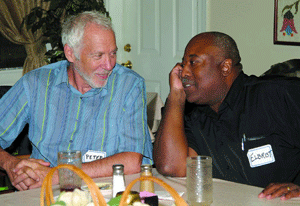
Possibilities
Develop Leaders
Newsletter December 2005
Peter Block and Rev. Elbrist Mason in Clarksdale, August 2005


One way to define leadership is the art or notion of getting things done. This methodology is quick, simple and complete. The reason we think of it as complete is because it usually relies on the same person or technique for getting things done. Yet, it stops the development and maturity of potential new leaders from emerging within a community or organization.
I confess that this was my mode of leadership for many years. Although I tried other leadership styles, the results always lay in getting things done myself. This understanding of leadership was a part of me until I move to Clarksdale, Mississippi. After getting settled into the community, Doris Miller, a 2005 Mayoral candidate and community leader, invited me to attend a Mastery Foundation event. Her invitation introduced me to a new way of leadership.
The Mastery Foundation’s Community Empowerment workshop challenged and invited me to a new model of leadership that empowered people to get things done by accepting responsibility for themselves and the possibilities they created. This was not another heaping dose of the self-help industry’s hype. No! I was invited to engage in and take on a new way of being and a new way of doing, which leads to empowerment. This way of empowerment develops people who can and will make changes for the betterment of themselves and their communities.
After attending the Mastery Foundation program, I had an opportunity to see this leadership idea grow. Our group, the Clarksdale Community Council, took on bringing Dr. Horace Boyer to Clarksdale. Initially, everyone was excited about bringing this renowned musician, composer, singer, and minister to our community. However, as time drew near and other projects began to collide, we lost our focus. We were spending our time and efforts on the wrong things.
In a word, everyone was doing what he or she thought was best, instead of working together. We were each doing our own thing and not talking with each other. We were working from the traditional leadership models where each person is doing her or his own thing. The goal becomes getting something – anything – accomplished. Then no matter what happens, even if nothing really changes, one could say, “Something was done, and at least I did my part.”
In response to our dilemma, I took a lesson from the Mastery Foundation workshop --communicate and communicate often. Possibility leadership is accountable and invitational. Everyone on the team is encouraged to be in contact with each other weekly or even daily.
Constant availability and focused communication create two levels of possibility leadership. The first level is access and opportunity for everyone. The second level is an understanding of potential outcomes. Essentially, possibility leadership leaves no one out of the process. (In traditional leadership models not only can you be left out of the process; you may never really know what is happening.)
During the time we were working on the Horace Boyer concert, three things emerged for me that further tied me to possibility leadership. First, a community (team or group) must share and invite each other to be real (accountable) in their quest for success. It is not enough to have goals and tasks. Second, the community must encourage each person to be true not only to their part in the process, but to the whole process and result. For instance, during the Boyer concert’s promotion some group members could not continue for various reasons. The group responded to this by looking within for continued possibility leadership, and this made it easier to reshuffle duties and responsibilities.
Third, no one wants to be the bearer of bad news. But not sharing bad news – such as a church group pulling out of the project – led to miscues, misunderstandings and disempowerment. We learned that we needed to be specific about what was happening without getting caught up in whether we thought it was good or bad. This meant that our time together was spent on the possibilities rather than the blame game of the traditional leadership model.
Possibility leadership led to wonderful luncheons (meetings) where we shared openly such things as “My church has decided not participate, but I will continue with the possibility.” This was empowered leadership, particularly since it broke the traditional mode of blaming others. Our group moved from needing someone or something from the outside to get us through to embracing and deciding for ourselves what was possible. We moved to a place of being and doing without having to carry all the usual stuff that makes leadership a burden.
Using the Mastery Foundation’s principles of being (empowerment) produced possibility leaders in our group. These leaders modeled the behavior of engaging, empowering, encouraging, and employing people in our community. The concert was an event that challenged us to do without our normal ideas of winning by doing everything ourselves and blaming those who didn’t participate. Our focus was on building community leaders who in turn would develop and implement programs or projects that would make our lives together better. In essence, we learned that we already had what we needed to be possibility leaders in Clarksdale, Mississippi.
I see the possibilities in Clarksdale, Mississippi, even if sometimes only I see them. I know I have the power within to create and build without waiting until everyone else gets together whatever it takes to do this or that in the community. Yes! We can make a difference by engaging, encouraging, empowering, and employing God’s people to move through the possibilities we create – the possibilities we are – now rather than later.
Rev. Elbrist Mason
Haven United Methodist Church
Clarksdale, Missisippi